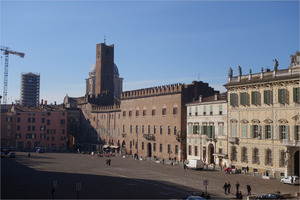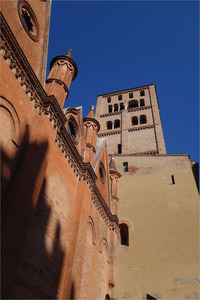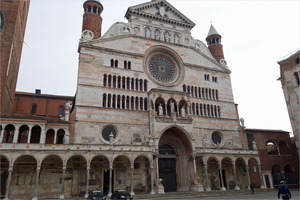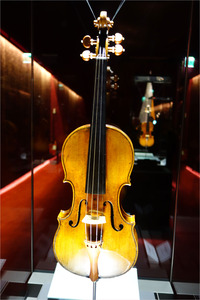An early sequence in Bernardo Bertolucci’s film 1900 shows a distraught character dressed as Rigoletto proclaiming to anyone who will listen the news that Verdi is dead.
 The image came back vividly in the small front courtyard of a 15th century house in Mantua, said to be the court jester’s home in the city where the eponymous opera is set and a bronze statue of him, in cap and bells, now stands.
The image came back vividly in the small front courtyard of a 15th century house in Mantua, said to be the court jester’s home in the city where the eponymous opera is set and a bronze statue of him, in cap and bells, now stands.
The first opera still regularly performed, Monteverdi’s Orfeo, was composed for the Gonzaga dynasty, rulers of Mantua for some 400 years.
Perhaps Bertolucci intended that scene to stand out from his sprawling and disturbing polemic about the rise of fascism in Italy as a reminder that, while the horrors of conflict may come and go, art endures.
Nowhere is this illustrated so clearly as in the Po Valley of Northern Italy where the events on which the film was based took place. Music, visual art and architecture overwhelm the visitor like the floods which long beset that flat, fertile river basin. The Alps rise on the horizon to the north, where Lombardy borders Switzerland. From the top of the campanile in Cremona it is sometimes possible, in clear conditions, to see the Apennines to the south. It’s almost as though the featureless terrain was the stimulus for the creation of great and lasting buildings.
 Mantua is best first see from across the causeway between the middle and lower lakes, two of three, created to replace the swamps which once impinged on the city and which provided it with a partial defensive barrier. The harmonious impact, though somewhat spoiled by lingering, intrusive repair work resulting from an earthquake in 2012, is impressive.
Mantua is best first see from across the causeway between the middle and lower lakes, two of three, created to replace the swamps which once impinged on the city and which provided it with a partial defensive barrier. The harmonious impact, though somewhat spoiled by lingering, intrusive repair work resulting from an earthquake in 2012, is impressive.
Everything worth visiting is in easy walking distance. The rich collection of art once amassed by the Gonzagas in the sprawling Palazzo Ducale was part sold to offset a financial crisis and part looted by Napoleon’s army but the palace is crucial to a grasp of Mantua’s history and still dazzling, if only for Pisanello’s masterly, incomplete frescoes – uncovered in the 1960s – and some wonderful tapestries from Brussels.
Intriguing in a more eye opening way is the Palazzo Te, used as a place of entertainment and a love nest (though nest hardly describes such a grand residence) by a scion of the ruling family who conducted an affair with his mistress there. Its ceiling frescoes include one of such lifelike horses you half expect them to snort, one of the humbling of giants which Dickens feared might put the viewer at risk of a stroke – and one clearly intended to get the sexual juices running.
 But an even greater eye opener is the cathedral, a large part of whose exterior is hidden behind secular buildings, prompting a sharp intake of breath from the visitor who enters by the west door to discover he enormous cavern of its interior.
But an even greater eye opener is the cathedral, a large part of whose exterior is hidden behind secular buildings, prompting a sharp intake of breath from the visitor who enters by the west door to discover he enormous cavern of its interior.
Finally nobody should leave Mantua without at least a quick look at the gorgeous Bibiena Theatre. Built on a bell shaped floor pattern, it was inaugurated in December, 1769. The following month a 13 years old Mozart played harpsichord there.
Cremona, about an hour’s drive away, also has a lovely old theatre, which hosts an annual Monteverdi festival. The façade of the city’s cathedral is a fascinating layer cake of architectural styles. There’s a huge fresco inside with a frame around it, which fooled Napoleon into think he could cart it off to Paris. To one side of the cathedral is the bell tower, claimed to be the tallest brick structure in Europe, to the other the Baptistery, whose dome is an amazing, red brick balancing act.
 But Cremona’s great claim to fame is violins. There are no fewer than 157 violin makers in the city. 157 Stradivari (aka Stradivarius) came to work there, learning his trade under Nicolo Amati. The superb Violin Museum contains instruments of such age and craftsmanship that they are worth a small fortune. There’s the 1727 Stradivari Vesuvius, for example, so called because its reddish tinge has hints of molten lava – but which is not so precious that it isn’t taken out of its glass case to be played now and then.
But Cremona’s great claim to fame is violins. There are no fewer than 157 violin makers in the city. 157 Stradivari (aka Stradivarius) came to work there, learning his trade under Nicolo Amati. The superb Violin Museum contains instruments of such age and craftsmanship that they are worth a small fortune. There’s the 1727 Stradivari Vesuvius, for example, so called because its reddish tinge has hints of molten lava – but which is not so precious that it isn’t taken out of its glass case to be played now and then.
If you aren’t lucky enough, as I was, to hear it played live, you may sit under an acoustic wooden shell to hear the rich sounds created, largely from Dolomites spruce and Balkans maple, by Cremona’s masters. They helped blot out some of the nastier images recalled from 1900, a film which provoked mixed responses to say the least, which were drawn from the particularly ugly confrontation between fascists and their opponents in the Po valley. Sadly that confrontation has reared its head again recently but I guess, like me, you’ll be happy to have such thoughts soothed away by the music.
Further information at www.wonderfulexpo2015.com.











